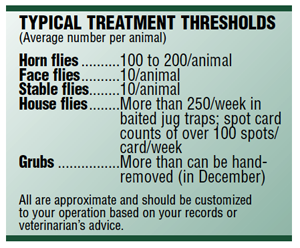Concerns with indiscriminate insecticide use in the environment have led today’s cattle producers to take a broader approach to fly control. Such an improved approach emphasizes these steps:
-
Study the problem. Approach pest control much like you would vaccination: Don’t automatically apply products without a measurable need and a good plan. Keep accurate and up-to-date records of fly levels, actions taken, and success or failure. Use pest scouting to know which species you’re up against, and learn the lifecycles for timing effective control programs.

- Target controls. Flies don’t affect all classes of cattle equally. Target treatments and cattle groups based on economic thresholds and timing. That permits you to apply products when they’re likely to have their most impact.
- Incorporate management. Chemicals won’t do it all. Eliminate fly breeding sites. Dispose of accumulated manure. Remove decaying wet organic matter. Fix leaking tanks and other drainage problems.
- Monitor progress. Use regular pest scouting and other monitoring tools to assess results. If you see lack of effectiveness in a product, determine if the product is being used properly.
- Monitor the economics. By tracking the return to fly control investments, you can rationally adopt or discard practices. Monitoring also helps you evaluate all costs and returns, particularly when adopting methods that bring additional value, such as feedthrough insecticides combined with nutritional supplements. These types of products improve returns on two fronts for the same investment, not only reducing fly numbers but also adding needed mineral and protein nutrition at the same time.
The economic impact of fly control is the traditional hot debate. Here are some things we know:
- US and Canadian studies demonstrate that grazing yearlings free of horn flies gain anywhere from 15 to 50 pounds more than heavily infested animals. Weaning weight of calves can also be reduced from 3 percent to 16 percent because horn flies reduce milk flow in cows. More recent studies, in Louisiana and Wyoming, suggest lower fly numbers than previously believed may cause losses—down to as few as 12 to 23 face flies or stable flies per animal, depending on grass conditions.
- Even low, stable fly populations can cause from 0.1 to 0.48 pounds of lost gain per day…even greater when heat stress becomes a factor.
- When considering the economics of common housefly control, don’t downplay the public-relations value. Fly populations significantly contribute to nuisance complaints against livestock operations.


